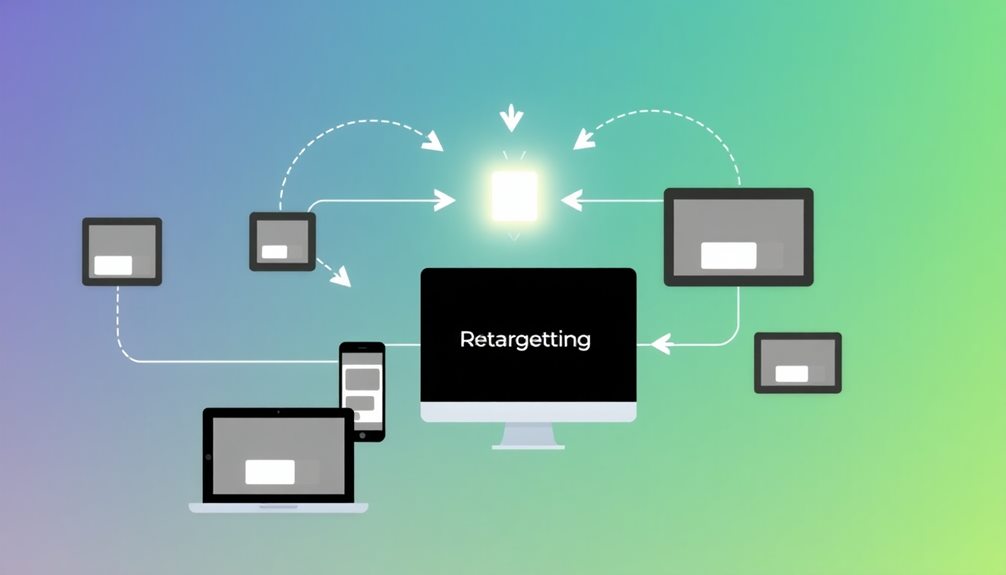Retargeting pixels are amazing tools that boost your marketing by reminding visitors about the products they loved! When someone visits your website, a tiny piece of code drops into their browser, turning them into potential customers. Later, they'll see ads about those very items while browsing other sites. This keeps your brand fresh in their minds and makes them more likely to return and buy. Plus, most shoppers forget about their carts, but with retargeting, you can bring them back! Isn't that exciting? Keep discovering how you can make your marketing efforts even better!
Key Takeaways
- Retargeting pixels drop cookies in browsers, enabling brands to display targeted ads for previously viewed products, enhancing user engagement.
- Personalized retargeting ads can increase conversion rates by up to 128% by reminding users of their interests and abandoned carts.
- Effective retargeting strategies, including audience segmentation, can recover about 30% of users who abandoned their carts.
- Users exposed to retargeted ads are 70% more likely to convert, making retargeting a cost-effective marketing approach.
- Dynamic retargeting ads provide tailored product recommendations based on user behavior, significantly improving engagement and brand recall.
Understanding Retargeting Pixels
When you visit a website and then see ads for products you just looked at, that's the power of a retargeting pixel at work. These tiny pieces of Javascript code drop an anonymous cookie in your browser. This cookie helps businesses track what you've been interested in, so they can show you ads for those products later. It's like a friendly reminder of the things you liked!
Retargeting pixels are super useful for brands. They help boost conversion rates, which means more people decide to buy what they see. In fact, retargeted users are 70% more likely to engage with ads compared to those who haven't been retargeted. That's huge!
You can even customize these pixels using Standard Event codes. This means they can react to specific actions, like when you add an item to your wishlist or finish signing up for a newsletter.
How Retargeting Works

Retargeting is like a friendly reminder from your favorite store!
When you visit a website, a little piece of code drops a cookie in your browser, helping brands remember you.
This way, when you're browsing elsewhere, you'll see ads for things you liked, making it easier to find what you want again!
User Engagement Strategies
By placing a retargeting pixel on your website, you can effectively track visitors and reconnect with them later through targeted ads. This not only boosts user engagement but also helps improve conversion rates!
Understanding how to write and earn can enhance your approach to utilizing retargeting strategies. Here are some fun ways retargeting can work for you:
- Target Past Visitors: Show ads to people who've already visited your site, reminding them of what they liked.
- Reduce Cart Abandonment: If someone leaves items in their cart, serve them ads within a few days to encourage them to complete their purchase.
- Segment Your Audience: Use data from retargeting pixels to group users based on their interests, making your ads more relevant.
- Increase Brand Recall: Repeated exposure to your ads helps users remember your brand, making them more likely to return.
- Create Personalized Messages: Tailor your ad content based on what users interacted with, making them feel special and valued.
These strategies help you connect with your audience in a meaningful way. So, don't miss the chance to engage users and watch your conversion rates soar!
Conversion Rate Optimization
Boosting conversion rates is all about understanding how to effectively leverage retargeting strategies. When someone visits your website, a retargeting pixel drops a little cookie in their browser. This cookie helps you track their behavior and serve them personalized ads later, similar to the concept of budget management in finance, where you tailor your spending based on past habits.
Imagine seeing ads for something you looked at just days ago! That's the magic of retargeting.
Users who see these targeted ads are 70% more likely to convert, which means they're more likely to make a purchase. Isn't that exciting? By reaching out within two to three days after they abandon their cart, you can recover lost sales. Most people decide to buy shortly after browsing.
Another smart move is to segment your audience based on their behavior. This way, you can create tailored ad experiences that make your ads even more engaging.
With effective retargeting, you could see a conversion boost of up to 128%!
Benefits of Using Retargeting

Harnessing the power of retargeting can considerably enhance your marketing efforts, leading to impressive benefits for your brand. When you use retargeting campaigns, you're reaching out to people who already know about you. This can boost conversion rates by up to 70%!
Here are some fantastic advantages:
- Recover Lost Sales: Retargeting can bring back about 30% of users who abandoned their carts.
- Boost Brand Awareness: Seeing your ads multiple times helps people remember your brand better.
- Cost-Effective: Retargeting usually costs less than traditional ads, saving you money.
- Increase Engagement: Users who've interacted with your site are more likely to engage with retargeted ads.
- High ROI: Businesses can see returns of up to $1.60 for every dollar spent on retargeting campaigns.
Challenges in Retargeting

Steering through the landscape of retargeting comes with its own set of challenges that marketers must address to guarantee success. One major hurdle is privacy concerns. You need to make certain your data collection methods are compliant with laws like GDPR, which means being transparent about how you track user behavior. If you don't, it could hurt your brand's reputation.
Additionally, the rise of AI technologies has raised significant concerns about data security and privacy violations, making it even more important to navigate these issues responsibly. AI's impact on privacy also emphasizes the need for marketers to be vigilant.
Another challenge is ad frequency. It's crucial to find the right balance. If you show ads too often, people might get annoyed and start ignoring them or even using ad blockers. This can lead to negative feelings about your brand and lower your return on investment.
You might be surprised to know that about 80% of website visitors don't take action right away. Without effective retargeting, you could miss out on engaging these potential customers.
Real-World Applications

Imagine you're browsing online and see ads for products you've checked out before.
That's the magic of retargeting pixels! They help brands show you personalized product recommendations, making it easier for you to find what you love and boosting the chances of a fun shopping experience.
Effective Ad Engagement
Effective ad engagement through retargeting pixels can considerably transform your marketing strategy. By reminding potential customers about the products they viewed, you can create personalized ads that pop up on platforms like Facebook and Google Display Network.
This method not only boosts conversion rates but also helps you recover lost sales from those pesky abandoned shopping carts.
Here are some great ways retargeting can enhance your ad placement:
- Recapture lost interest: Target users who left items in their cart.
- Increase brand recall: Retargeted ads can boost brand recognition by up to 70%.
- Tailor your message: Show special discounts to users who showed interest but didn't buy.
- Focus on warm audiences: Convert familiar customers instead of cold traffic.
- Drive higher conversion: Businesses can see a 51% increase in conversions through effective retargeting and remarketing.
Personalized Product Recommendations
Personalized product recommendations are revolutionizing the way brands connect with consumers online. When you visit a website and look at products, retargeting pixels remember your choices. This cool technology tracks what you view or add to your cart. Later, when you see ads featuring those items, it feels special and tailored just for you!
With dynamic retargeting ads, brands can show you specific products based on your past interactions. This leads to a 70% higher chance of you engaging with the brand again. Pretty neat, right?
Businesses that use personalized recommendations from retargeting pixels often see a huge boost in conversion rates. Some even report increases of up to 128% in sales!
You might also receive tailored incentives, like discounts on items you've checked out before. This encourages you to complete your purchase.
Plus, abandoned cart emails paired with personalized ads get opened 40% more often!
Retargeting vs. Remarketing

Retargeting and remarketing are two powerful strategies in digital marketing, each serving distinct purposes to re-engage your audience. You might think they're the same, but they actually focus on different methods.
Retargeting uses online display ads to reach users who've visited your website before. In contrast, remarketing usually involves sending emails to people who've interacted with your brand.
Here are some key differences between retargeting and remarketing:
- Retargeting uses tracking pixels or cookies for online ads.
- Remarketing relies on email campaigns using visitor contact info.
- Retargeting ads appear across various digital platforms.
- Remarketing nurtures leads through personalized communication.
- Retargeting is great for converting interested visitors.
Both strategies aim to bring back users familiar with your brand.
Retargeting is perfect for attracting mid- to low-funnel prospects, making them 70% more likely to convert.
Implementing Retargeting Strategies

To harness the full potential of retargeting, start by implementing effective strategies that will re-engage your audience.
First, install a Retargeting Pixel on your website. This pixel drops an anonymous cookie in visitors' browsers, allowing you to track their actions and serve them tailored ads later. Isn't that cool?
Next, focus on audience segmentation. You can categorize users into hot, warm, and cold audiences based on how they interacted with your site. This makes your ads more relevant and exciting!
For example, if someone views a product but leaves without buying it, following up with a targeted ad within two to three days can help recover that lost sale. Did you know that about 70% of online shoppers abandon their carts?
Using standard event codes with your Retargeting Pixel lets you customize ads based on specific actions, like viewing products or abandoning carts. This personalization can greatly boost your conversion rates!
Optimizing Retargeting Campaigns

Optimizing your retargeting campaigns can greatly boost your marketing effectiveness and drive higher conversion rates.
You want your ads to catch attention and make people click! Here are some tips to help you get the most out of your campaigns:
- Use engaging headlines that spark curiosity.
- Choose visually appealing media to grab the viewer's eye.
- Create click-worthy call-to-action buttons with contrasting colors and action words.
- Tailor ads for specific audience segments based on what they liked before.
- Regularly analyze performance metrics like click-through rates and conversion rates.
Frequently Asked Questions
Why Is Retargeting Important in Marketing?
Retargeting's important in marketing because it helps you reconnect with potential customers who've shown interest. By keeping your brand in their minds, you greatly increase your chances of converting those visitors into loyal buyers.
What Does a Retargeting Pixel Do?
A retargeting pixel tracks users who've visited your site, dropping a cookie in their browser. It helps you display targeted ads later, reminding them of your brand and encouraging them to return and convert.
What Is the Impact of Retargeting?
Retargeting boosts your marketing by re-engaging visitors who've shown interest in your products. It increases conversion rates, enhances brand recall, and effectively targets abandoned carts, ultimately leading to higher sales and improved ROI on your efforts.
How to Use Retargeting in Advertising to Increase Conversion?
To increase conversion, focus on implementing retargeting ads soon after user interaction. Tailor your messages based on their behavior, like cart abandonment, and segment your audience for maximum relevance and engagement. You'll see results!
Conclusion
In the wonderful world of marketing, retargeting pixels are like friendly nudges that remind your audience about what they love. By using these magical tools, you can bring back visitors who might've wandered off. It's all about reconnecting and showing them what they're missing! So, as you plunge into retargeting strategies, remember—it's a joyful journey of bringing people back to your brand. With a little effort, you'll see great results and happy customers!










